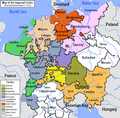| Name | Type of entity | Comments |
|---|
| Beilstein | Lordship | Held by the Counts of Nassau-Dillenburg from 1343 |
|---|
 Cologne Cologne | Prince-bishopric | (Re-)established by King Otto I in 953, Prince-elector and Archchancellor of Italy in 1356; including Vest Recklinghausen and the Duchy of Westphalia |
|---|
 Koblenz Koblenz | Bailiwick | An administrative grouping of lands including the immediate Lordship of Elsen, held by the Teutonic Knights, 2nd Rhenish Prelate |
|---|
 Mainz Mainz | Prince-bishopric | Archbishopric established in 781 by Pope Adrian I, Prince-elector and Archchancellor of Germany in 1356; including Eichsfeld, Erfurt, and Aschaffenburg |
|---|
 Nieder-Isenburg Nieder-Isenburg | County | Emerged from Isenburg-Isenburg in 1199, partitioned in 1502 into Isenburg-Grenzau and Isenburg-Neumagen (to Sayn-Wittgenstein in 1554), extinct in 1664 |
|---|
 Palatinate Palatinate | County palatine | Arose from the allodium of the Count palatine of Lower Lorraine in 1085 under Henry of Laach, held by the House of Wittelsbach from 1214, Prince-elector and Truchsess in 1356 |
|---|
 Rheineck Rheineck | Burgraviate | Fiefdom of Cologne around Rheineck Castle [ de; fr ], held by the Freiherren of Varsberg from 1576 |
|---|
 Thurn und Taxis Thurn und Taxis | Barons | Briefadel without territory, Freiherren from 1608, Counts from 1624, raised to Princely Counts in 1695 |
|---|
 Trier Trier | Prince-bishopric | Established in 902, Prince-elector and Archchancellor of Burgundy (Arles) in 1356 |
|---|



